6 Company Culture Examples Every Manager Should Examine
Steven Johnson, Science Author & Media Theorist, was right when he said:
If you look at history, innovation doesn’t just come from giving people incentives. It comes from creating environments where their ideas can connect.
Now, you can ascribe the workplace environment (and culture) Steven talked about to Atlassian, the US-based software company.
And here’s why.
The company’s founders and managers wanted to build a creative environment that fosters innovation. I’m talking about an environment where employees are always coming up with great ideas. The result of this refreshing idea?
ShipIt Day is a 24-hour window where Atlassian employees drop any company-related work and focus on a creative or side project. Despite being a tech company, these side projects don’t necessarily have to be technical.
They could be anything, really, as long as employees have fun creating it.
So far, this cultural practice is how Atlassian invented Jira Service Desk, a DIY video studio, Atlassian Invaders, and other innovative inventions.
Apart from cool inventions, this practice promotes team collaboration, passion, and proactiveness. All these are part of Atlassian’s core values, and the managers reiterate them in all the company’s actions.
Rituals like this makeup Atlassian’s exemplary company culture.
The company is now worth over $1.6 billion, and a large percentage of this success is due to its culture. Co-Founder Scott Farquhar shared why the company spends time building its culture.
He said:
From the beginning, our goal was to build a long-term company. We want to build a company that will stand the test of time. That’s why we spend a lot of time on company culture.
With over 5,700 well-managed employees, they’ve sure got it right in the company culture department.
Below is an overview of Atlassian’s company culture:
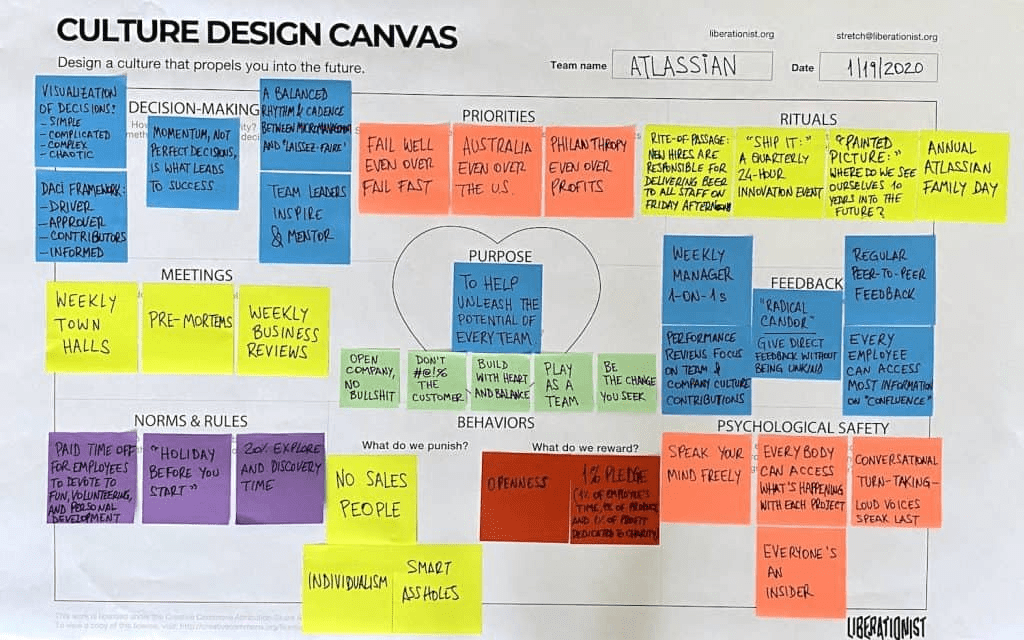
As a manager, you may be asking: How does Atlassian’s example help me shoulder the responsibility of improving company culture in my workplace?
Well, that’s what I’ll cover in this article.
As you go down this page, you’ll learn a few things. First, you’ll find some exciting company culture examples. More importantly, you’ll see how to track and improve yours with team pulse surveys:
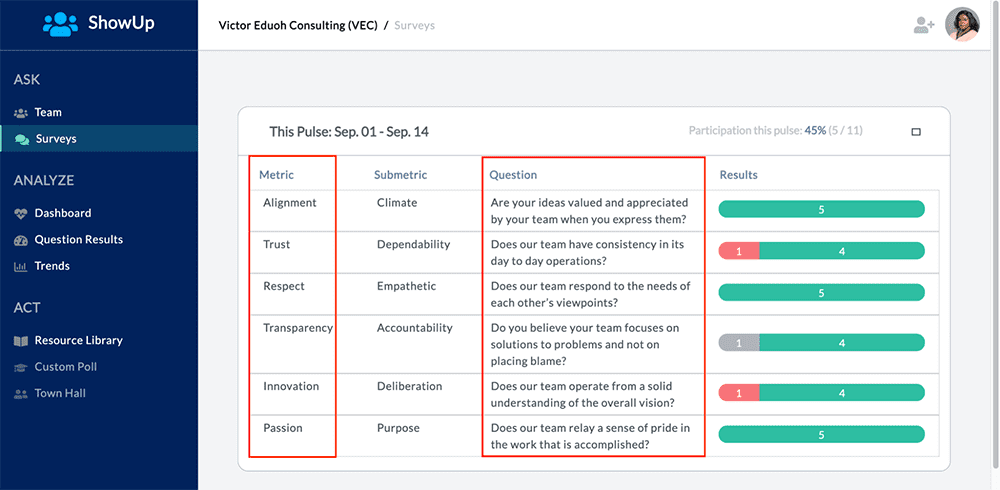
A company building its culture with bi-weekly team pulse surveys with ShowUp
Build Your Company Culture with Pulse Surveys
Table of Contents:
Before we look at some great company culture examples, let me establish some reverse groundwork.
What Makes a Company’s Culture Bad?
Asked differently, how can you identify positive or negative workplace culture?
This question is crucial because regular employee behaviors are often misinterpreted as company culture signs.
Let me explain.
As a manager, you’ll encounter employees in various moods like:
- The happy shout your social media manager gives when your company’s Twitter page hits 10k followers (excited mood).
- The moan from your developer when your website crashes (distressed mood), or
- The twitching fingers of the new intern when he’s called into the CEO's office for the first time (nervous mood).
These moods are normal and part of everyday organizational life.
They don’t generally represent the status of the company's culture. Good or bad culture goes beyond these, and we’ll explore it in a moment.
But before that, let’s do some managerial introspection.
Ask yourself the following questions, and be honest with the answers:
- What is the general mood of my employees on an average day?
- How do my employees describe the company to their friends and family?
- What sort of reviews are these employees leaving on sites like Glassdoor or Comparably?
- Do these employees rate me, the manager, well?
This last question is crucial, and you must take finding the answer seriously.
That’s because research shows employees who rate their managers poorly are 4 times more likely to interview for other positions. However, the reverse is true when compared to their peers, who rate their managers quite well.
It proves that, as a manager, you have a direct impact on your team member’s experience. And, by extension, your company’s culture.
Going back to the promise I made earlier on, let’s look at how bad company culture develops (and touch briefly on how you can curb it).
How does bad company culture develop?
Bad culture can form when the leadership team and managers fail to track the ever-fluctuating feelings of employees, otherwise called employee pulse.
As a manager, you should check your team’s pulse regularly (weekly or bi-weekly). Doing this lets you detect early enough if they’re unhappy or disengaged.
And an easy way to do this is via anonymous team pulse surveys.
For instance, Asana founders, Dustin Moskovitz and Justin Rosenstein, used pulse surveys to improve their culture.
In a report by Fast Company, Justin said:
We actively survey people anonymously. During one-on-one’s, we ask what’s working well and what isn’t working well. Based on that information, we go back to the company and say, here’s what we heard, and here’s what we’re going to do about it.
Sending out pulse surveys with specific questions is what every manager should be doing for their team. And with ShowUp, you can automate the entire process.
ShowUp’s employee pulse survey software helps you keep a finger on your team’s pulse. It does this via its automated weekly or bi-weekly pulse surveys:
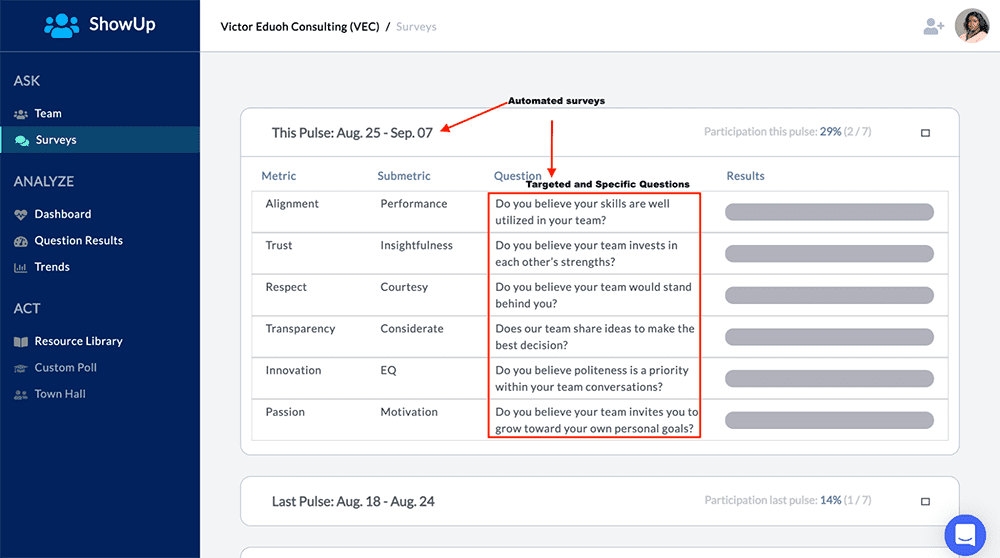
Once sent to employees’ emails based on your preference, the software also transitions them to complete these surveys via its smooth user experience.
ShowUp anonymizes feedback.
Doing this ensures that employees are open and free to speak their minds:
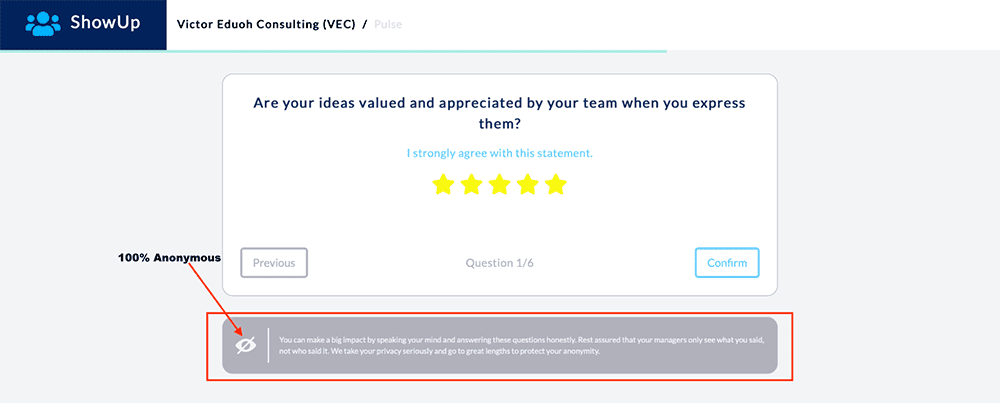
Examples of companies with good culture
- Propellernet
- Asana
- Hireology
- Bentos
- Updater
- CB Insights
- Zappos
Propellernet
Surely, a company with a staff turnover rate of just 7% knows one or two things about good culture, right?
I’ll say yes, especially when compared to its sector average turnover rate of 30%. That is why Propellernet is the first example on this list.
A digital marketing consulting agency, Propellernet has earned several awards for its culture. Their principles are: making life better and making dreams come true.
The founders (Jack Hubbard and Jim Jensen) shared vision was to build a workplace that encouraged workers to do world-class work.
In Nikki Gatenby’s (their Managing Director & Co-Owner) words,
It’s about an environment that encourages individual growth and personal connections, and a culture to shout about.
Now, on to the company’s culture.
Propellernet is all about the personal development of its employees. This is why they give each employee £1000 every year to develop themselves. Because of this, they have long-term employees.
Another fascinating culture of Propellernet is their “Dreamball Machine.”
Here’s what this practice is about.
Everyone in the company writes down their life dreams (one big dream and 3 small dreams per person). These dreams are then placed in a giant 80s bubble gum dispenser. Whenever the agency hits a milestone, a dream is randomly drawn from the bubble gum dispenser. And the company then goes ahead to fulfill that employee's dream.
The results?
Employees attending the World Cup in Brazil, and even cycling around Africa (Hello Africa!).
Propellernet quite literally fulfills the bucket list wishes of their employees!
A unique culture, if I must say. Of course, not every company can afford this (at least not a company in its early stages), and that's fine too. The idea of building a culture is not to copy another company’s culture verbatim but to draw inspiration.
Asana
Asana is another company whose rapid success is due to its strong organizational culture. From the very start of the company, they took deliberate steps to make the company a great place to work.
In fact, apart from their codebase, the next thing Asana’s founders drafted was the company’s core values.
This is why 96% of their employees say it is a great place to work. Pretty impressive, especially when compared to 59% of employees in a typical US-based company.
For us, it’s mission-critical that our culture enables our employees to do their most impactful work as effortlessly as possible. This supports the business and enables us to achieve our mission. Ultimately this enhances employee satisfaction and growth.
—Anna Binder, Head of People Operations at Asana
Hireology
How does a hybrid company make it to a list of companies with good cultures?
It is difficult enough to build a strong culture in a solely remote or physical company. But Hirelogy is a mix of both, and they manage to make it work, only because their culture is quite good.
How do they do it?
Andy Pinzhoffer, a software engineer at Hirelogy, said:
Good communication is essential, and we prioritize it.
Scott Brinkham, the VP of Product, also noted that the company promotes empathy. He shared some empathy-building activities that strengthen the bond between local and remote employees.
One of such activities is when a team member does another team member’s work for a few hours. This forces each team member to understand the demands of the next person's role.
Hirelogy's secret to good culture is clear communication and empathy. These two traits strengthen the relationship between the physical and remote workers.
Updater
Updater has a unique employment recruitment process. Instead of the traditional interview process, the company conducts full-day interviews.
Potential employees work on real projects during these full-day interviews. Doing this allows both parties (employer and candidates) to ascertain if they fit into each other’s culture.
Their approach works as they hire based on cultural fit, as much as intellectual fit. And it allows for an informed decision on both ends.
CB Insights
To encourage innovation, employees here have a hack day every quarter.
This is similar to Atlassian’s ShipIt Day mentioned in the introduction. On such days, CB Insights’ employees collaborate and work on any project they desire for 24 hours.
CB Insights’ primary focus is on employee growth and learning, a core essential of company culture in any company. They do this by offering a $1000 educational stipend to all employees. Also, they organize monthly peer-to-peer learning opportunities where employees learn something new.
The company’s managers and senior leaders aren’t left out.
They attend classes called 'Chubbybrain Sessions,' which teach core strategic management skills.
Zappos
This list wouldn't be complete without Zappos, the poster child for good company culture.
Zappos does this crazy thing: they offer trainees and new hires $2000 to leave after one week of training. This is to weed out people who genuinely love the company and its culture from those who don't.
They even conduct two interviews with potential candidates.
The first focuses on the candidate’s skill, and the second on culture fit. Apparently, cultural fit is a crucial criterion for them. It explains why their employees and new hires are familiar with their core values and fit into the culture.
By the way, did you notice what all the six companies mentioned above have in common? Of course, that’s beside the obvious two, all being successful companies and having a great culture.
Let me tell you what they all have in common...
Companies with a Great Culture Give Employees a Voice
Let’s talk briefly about this point: Giving employees a voice.
You see, if you aren’t giving the people you lead a voice to get real-time feedback, building a great culture will elude you.
But how can managers listen to employees and give them a voice, you ask?
Well, that’s where a teams’ pulse survey software comes in. With this, managers (like you) can send out weekly or bi-weekly surveys to listen and track team members’ pulse.
A tool like ShowUp automates the entire process for you.
It also gives you real-time insights pertinent to acting on employee pain points that are relevant to building up your company culture:
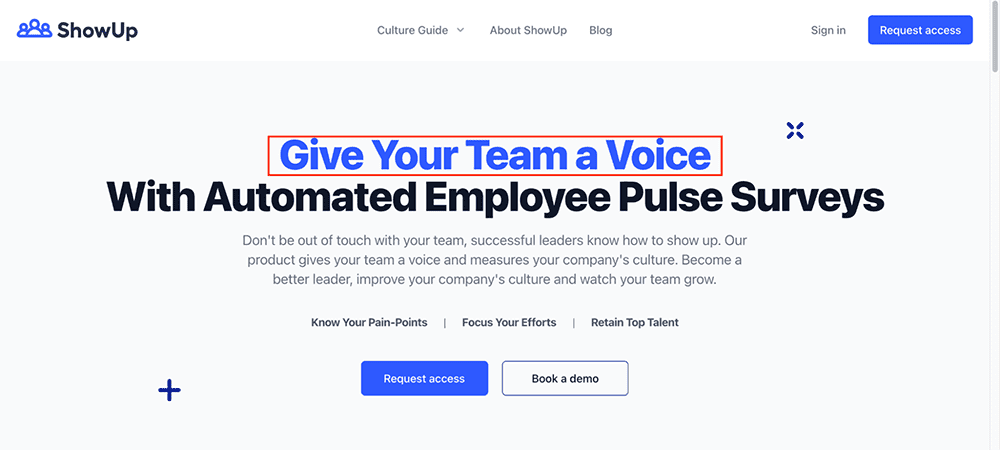
Give Your Team a Voice, Build Up Your Culture
The Best Culture For Your Company
We’ve looked at some successful company cultures.
Now, let’s talk about yours.
As a manager eager for a distinctive culture for your company, it’s tempting to copy these successful examples. After all, their approach has been proven to work.
But that’s a bad idea.
On creating a culture for your company, Oscar Wilde’s words come to mind. He said:
Be yourself; everyone else is already taken.
Copying another company’s culture is not a long-term solution. A Harvard Business Review article described such an approach as dangerous. Culture, like your business strategy, should be unique to the company in question.
Vartika Kashyap, Chief Marketing Officer at ProofHub, shared the same sentiment when she said she doesn't believe in imitation.
Vartika wrote:
I mean, how can you create a company culture by simply doing what some other company is doing? Culture is something indigenous to an organization. Therefore, it is not something you should try to copy from someone else. Look and learn, but don’t copy.
In other words, understand the basics of what creates a strong culture, but apply your company’s personality to it. Do otherwise, and you’ll end up mimicking surface elements and fail to make a cultural change relevant to your organization, according to another HBR report.
Let’s explore those company culture-building basics.
The basics of Good Company Culture
Based on the psychology-backed traits ShowUp tracks, 6 metrics (with 5 sub-metrics each) make up a good culture. We call this the ShowUp’s basic Culture Guide.
They include:
- An environment that fosters innovation,
- Transparency between management and staff
- Employee-management trust
- Respect
- Passion
- Alignment
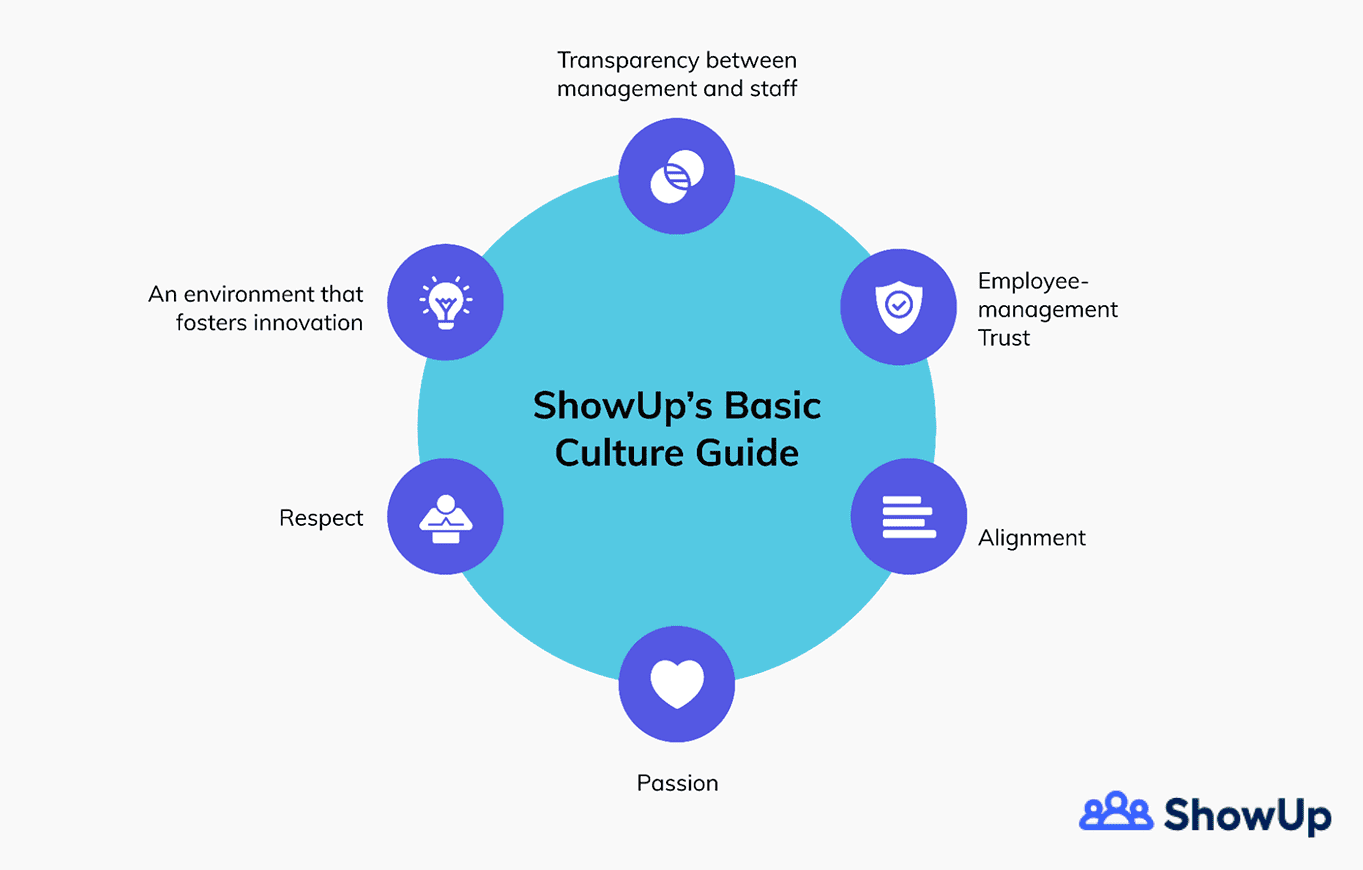
These traits are the building blocks and foundation of a healthy culture.
And so, the first step to upgrading your company’s culture to be on par (or better) than those shared above is to track, analyze, and act on these traits.
ShowUp simplifies things by automating the entire process for managers.
Below is an automated pulse survey sent from ShowUp by a company trying to build its culture. As you can see, the questions asked are aligned with the metrics and sub-metrics relevant to culture building:
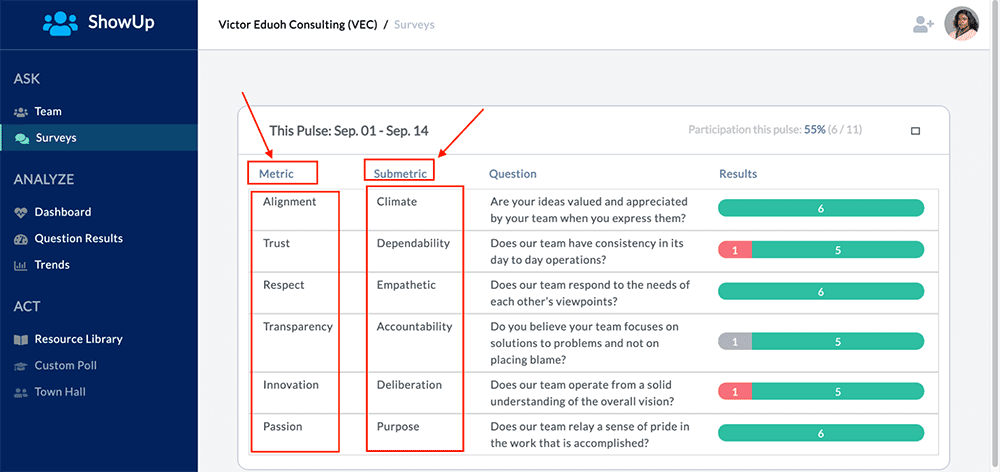
As responses from your employees come in, the software crunches the data.
This means that from one dashboard, you can see what metrics you’re excelling in and where you must improve to continue building your culture:
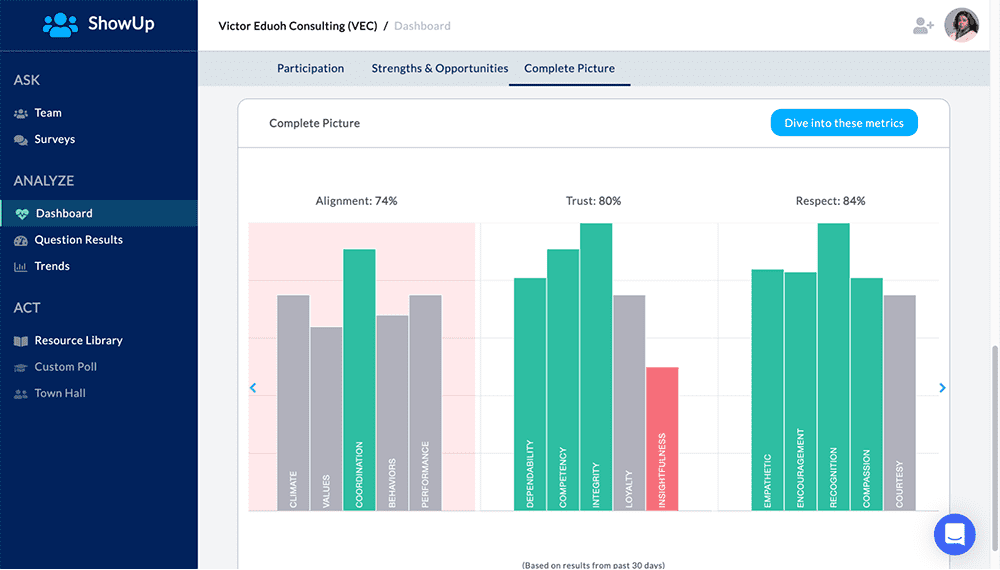
And that’s not all.
The Trends view drills into the sub-metrics of each primary culture-building metric, giving you more granular insights:

Conclusion: Start Building a Unique Company Culture
The culture of your company is necessary for its survival.
Ranjan De Silva, Partner & Senior Management Consultant, Sensei International, made an interesting analogy.
He said:
Organizational Culture is the “water” in the fishbowl. If the water is clean, it will nourish, energize, and let the fish thrive. But if the water is toxic, the fish will die, leaving the infrastructure value-less.
Building a unique and great company culture is a gradual process.
It doesn’t happen overnight.
But, with a tool like ShowUp, you can give employees a voice, use their feedback to monitor your progress, and make adjustments where necessary.
